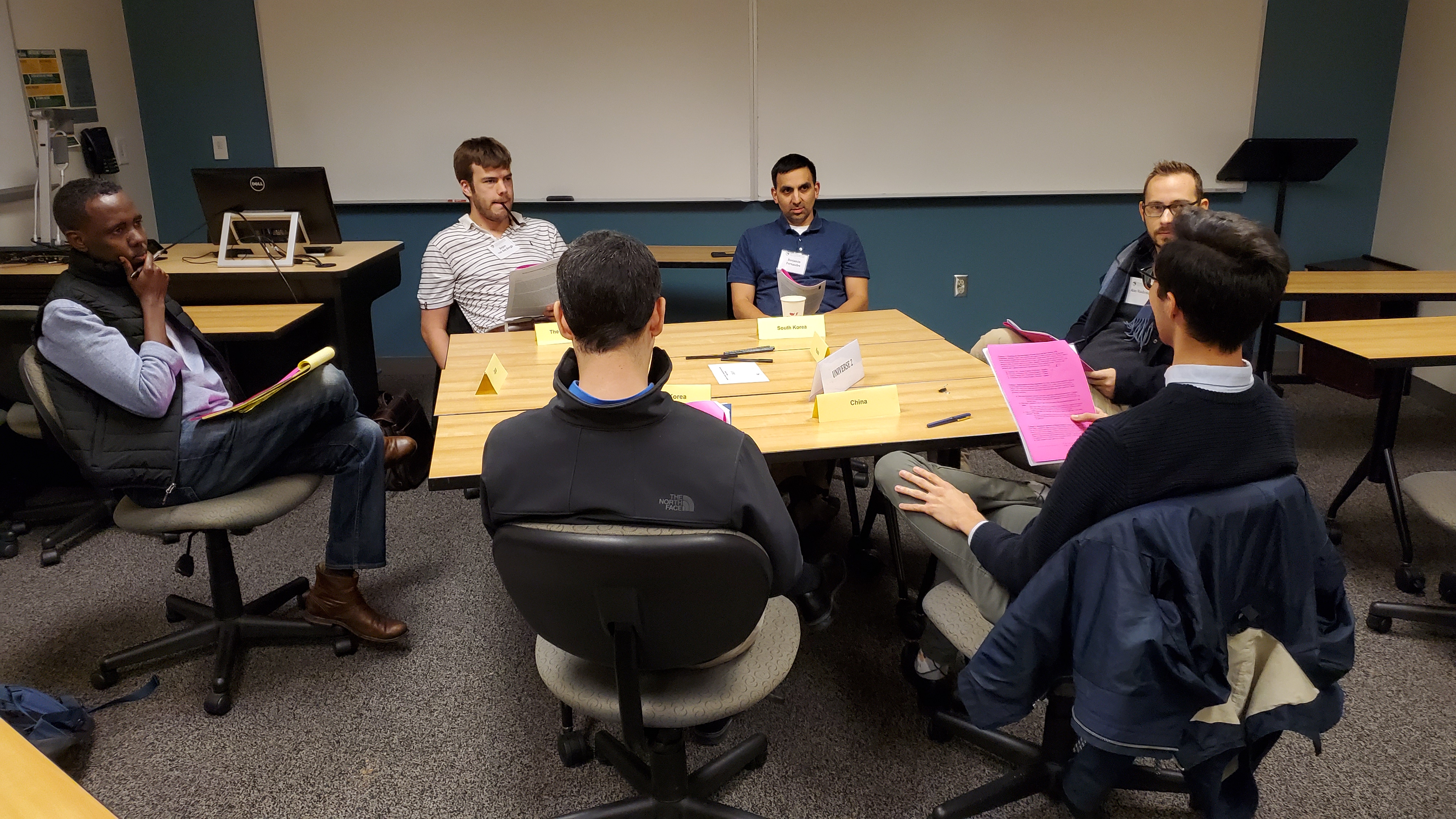On a chilly Saturday morning in November, graduate and undergraduate students from George Mason University descended on Van Metre Hall in Arlington. Once inside, they shed their identities as students and adopted the role of chief negotiator from one of six countries attempting to peacefully resolve North Korea’s nuclear weapons program. This wasn’t the result of a mix-up at the highest of diplomatic levels, but the Center for Security Policy Studies’ Fall Simulation.
The simulation, facilitated by the Korea Economic Institute of America (KEI), was based on the six-party talks which first took place in 2003 and continued intermittently until 2009. Although they were never fulfilled, the parties did commit to several important agreements as a result of these rounds of negotiation: namely, that North Korea would give up its nuclear program and return to the Nuclear Non-Proliferation Treaty in exchange for energy supplies. In the simulation, as in real life, settlements were hard-fought and some did not even materialize at all after hours of negotiation.
The participants were divided into five separate “universes,” each operating as their own mini simulation with a representative from the United States, Russia, China, Japan, South Korea, and North Korea. Students had two and a half hours to reach an agreement on four specific challenges, including setting priorities for the denuclearization of North Korea and addressing human rights concerns on the Korean peninsula.
Each of the countries that participated in the real life six-party talks had unique interests to defend. For example, China was wary of other countries in Asia acquiring nuclear weapons and a potential refugee crisis on its border. It viewed the talks as an opportunity to both defend itself and improve relations with the United States. The US, whose focus on the Iraq War diverted resources from the region, pressured China to take a more active role in mediation. Japan was first concerned about the ability for North Korean missiles to reach its territory and second about resolving the issue of North Korea’s abductions of Japanese citizens during the 1970s and 1980s. North Korea, conversely, used its nuclear weapons as leverage in a bid for the other countries to provide it with economic aid and ensure the survival of the Kim regime.
During the simulation, delegates passionately defended their assigned countries’ positions. Some groups got off to a shaky start—in one group, the North Korean negotiator left the talks to protest the actions of the other delegates. In another, the participants chose their seating arrangements strategically, putting the U.S., Japan, and South Korea on one side while Russia, China, and North Korea were on the other. This mirrored the real-world experience: something as seemingly minor as seating arrangements was even taken seriously. KEI’s Kyle Ferrier explained that in the original six-party talks, the U.S. delegation orchestrated a seating change so they were seated next to the North Koreans. This allowed the Americans direct access to the North Korean delegation at the table, enabling them to speak with them one on one.
While the simulation approximated the substance of a real-world nuclear arms negotiation, it necessarily simplified some aspects of actual diplomacy. Simulation negotiators could, for instance, unilaterally commit funds from their countries to compensate North Korea in exchange for giving up its nuclear program. But, the real world is not so straightforward. In the United States, congressional approval would be required before any Treasury funds are disbursed. Additionally, the negotiating team would be in touch with numerous other officials at the State Department and White House to ensure the country’s position is accurately represented.
Despite these simplifications, only three of the five groups successfully arrived at an agreement on all four challenges while the other two did not. Even under controlled circumstances with greater latitude with which to make agreements, negotiators still found reaching an agreement prohibitively difficult. In one unsuccessful group, the South Korean representative advocated so strongly for their position that none of the other countries could agree to their terms. When it became apparent that the rest of the negotiators would not meet the demands, talks collapsed. Similar stories occurred throughout the real-world six-party talks. In 2006, the talks broke down when North Korea demanded that U.S. financial restrictions and sanctions be lifted, a condition the U.S. would not accept.
Although the six-party talks have stalled indefinitely, several high-profile summits have taken place between the leaders of the United States and North Korea on the belief that negotiations can be most effectively handled at the presidential level. But in the years since the collapse of the original six-party talks, North Korea has continued to expand its nuclear weapons capability, from testing a hydrogen bomb in 2017 to testing a submarine-launched ballistic missile just last month. As recent history has shown, obstacles remain to a peaceful resolution on the Korean peninsula. Meeting the demands of all stakeholders will require the tireless work of diplomats and negotiation teams as incremental progress is made towards a final deal. Our student negotiators got a taste for just how frustrating and satisfying that process really is.
Kris Garriott is pursuing his Master’s in Public Policy with an emphasis in national security at the Schar School of Policy and Government. Areas of interests include terrorism and the rise of great powers in the 21st century. A native of Virginia, Kris has lived in Panama and loves to travel to new places. He currently works as a contractor in the Department of Justice’s Criminal Division.




